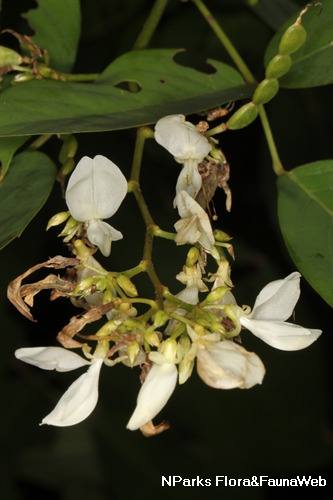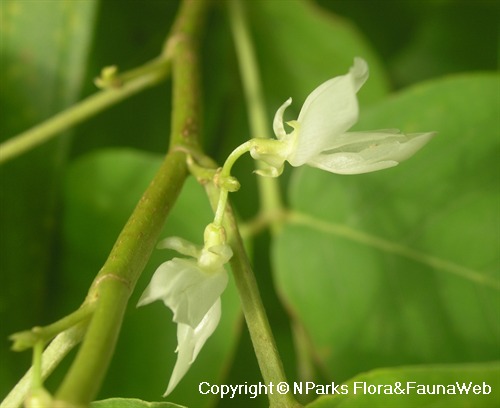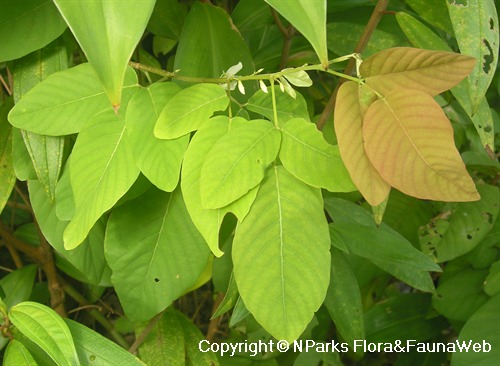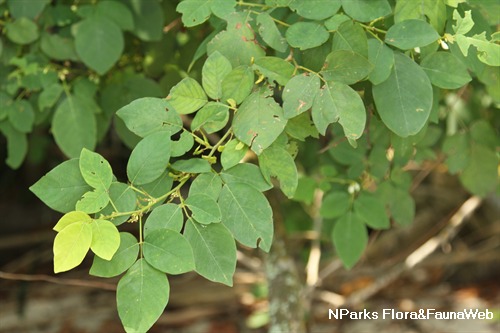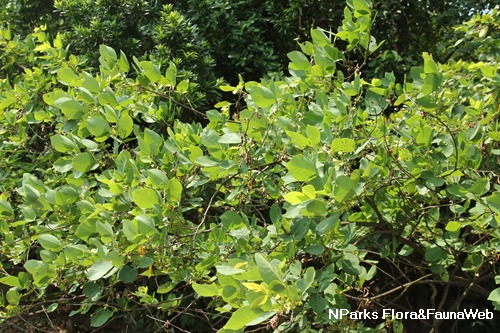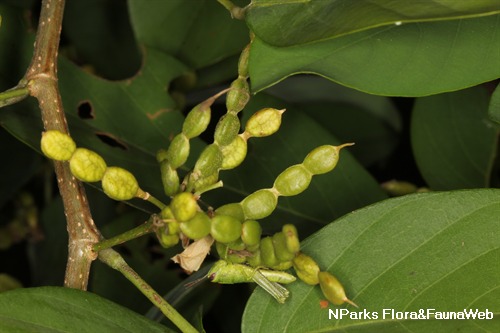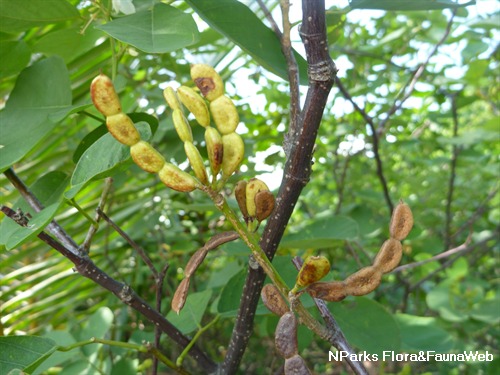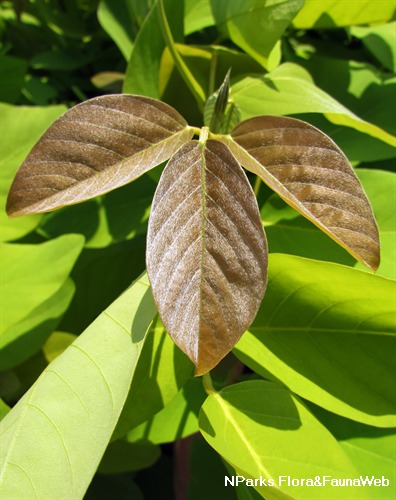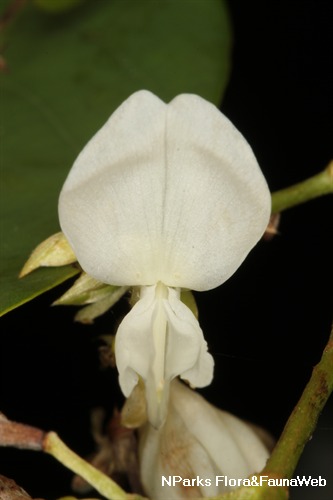
Back
Dendrolobium umbellatum (L.) Benth.
| Family Name: | Fabaceae (Leguminosae) |
| Synonyms: | Hedysarum umbellatum L., Desmodium umbellatum (L.) DC. |
| Common Name: | Dendulang, Petai Belalang, Petai Laut, Sea Dendrolobium, 伞花假木豆 |
Name
Classifications and Characteristics
| Plant Division | Angiosperms (Flowering Seed Plants) (Dicotyledon) |
|---|---|
| Plant Growth Form | Tree (Small (6m-15m)) |
| Lifespan (in Singapore) | Perennial |
| Mode of Nutrition | Autotrophic |
| Plant Shape | Irregular |
| Maximum Height | 6 m |
Biogeography
| Native Distribution | East Africa to tropical Asia to northern Australia and the southwest Pacific |
|---|---|
| Native Habitat | Terrestrial (Secondary Rainforest, Monsoon Forest, Coastal Forest, Grassland / Savannah/ Scrubland, Inland Cliff, Riverine), Shoreline (Mangrove Forest, Sandy Beach, Rocky Beach) |
| Preferred Climate Zone | Tropical, Sub-Tropical / Monsoonal |
| Local Conservation Status | Native to Singapore (Least Concern (LC)) |
Description and Ethnobotany
| Growth Form | It is a tree up to 6 m tall. |
|---|---|
| Foliage | Its pinnate, stalked leaves have leaflets that are elliptic to broadly egg-shaped, the underside of which are covered with fine hairs. The terminal leaflet is 5–17 by 2.5–8.5 cm, and the lateral leaflets 3–11 by 1.5–6 cm. |
| Flowers | Its flowering cluster consists of 10–20, 13 mm-long, white flowers. |
| Fruit | Its thick, elongated, leathery fruit pods consist of 3–8 segments that are 1-seeded, broadly elliptical-oblong to oblong, and 5–10 by 3.5–5 mm. |
| Habitat | It grows on rocky or sandy seashores or tidal mud, monsoon forest edges, river banks, rocky cliffs, savanna, and secondary forests from sea level up to 180 m altitude. |
| Associated Fauna | Its flowers are insect-pollinated. |
| Cultivation | It can be propagated by seeds. |
| Ethnobotanical Uses | Edible Plant Parts : Edible Leaves Food (Fruit or Vegetable): The young leaves are sometimes eaten as a vegetable or used as a seasoning. (Herb or Spice) Medicinal: It is used medicinally for treating gonorrhoea, irregular menstruation, scaly skin, as after childbirth medicine, as a general tonic, etc. Others: The plant is also used for cattle fodder. |
Landscaping Features
| Landscaping | It is a bushy plant, with pink young leaves, suitable for hedges or screening. It can tolerate brackish water and salt spray so it’s suitable for coastal sites. It is a shrub or tree suitable for gardens, parks and roadsides for borders or screens. |
|---|---|
| Desirable Plant Features | Ornamental Foliage, Ornamental Form |
| Landscape Uses | Coastal, General, Suitable for Roadsides, Parks & Gardens, Small Gardens, Beachfront / Shoreline, Hedge / Screening |
Fauna, Pollination and Dispersal
| Pollination Method(s) | Biotic (Fauna) |
|---|---|
| Seed or Spore Dispersal | Abiotic |
Plant Care and Propagation
| Light Preference | Full Sun |
|---|---|
| Water Preference | Moderate Water, Lots of Water |
| Plant Growth Rate | Moderate |
| Rootzone Tolerance | Waterlogged Soils (Drains Site), Moist Soils, Well-Drained Soils, Saline Soils / Salt Spray, Poor Infertile Soils, Fertile Loamy Soils, Easy to Grow |
| Propagation Method | Seed |
Foliar
| Foliage Retention | Evergreen |
|---|---|
| Mature Foliage Colour(s) | Green |
| Mature Foliage Texture(s) | Velvety / Furry / Tomentose |
| Prominent Young Flush Colour(s) | Pink |
| Foliar Type | Compound (Even-Pinnate) |
| Foliar Arrangement Along Stem | Alternate |
| Foliar Attachment to Stem | Petiolate |
| Foliar Shape(s) | Non-Palm Foliage (Ovate, Elliptical) |
| Foliar Venation | Pinnate / Net |
| Foliar Margin | Entire |
Floral (Angiosperm)
| Flower & Plant Sexuality | Bisexual Flowers |
| Flower Colour(s) | White |
|---|---|
| Flower Grouping | Cluster / Inflorescence |
| Flower Location | Axillary |
| Individual Flower Shape | Papilionaceous / Pea-shaped |
Fruit, Seed and Spore
| Mature Fruit Colour(s) | Brown |
|---|---|
| Fruit Classification | Simple Fruit |
| Fruit Type | Dehiscent Dry Fruit , Legume / Pod |
Image Repository
Others
| Master ID | 29607 |
|---|---|
| Species ID | 3916 |
| Flora Disclaimer | The information in this website has been compiled from reliable sources, such as reference works on medicinal plants. It is not a substitute for medical advice or treatment and NParks does not purport to provide any medical advice. Readers should always consult his/her physician before using or consuming a plant for medicinal purposes. |

